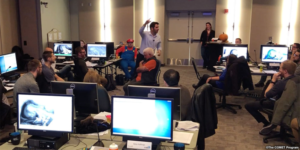This year’s course blended online and residence work, and contained online pre-requisites (videos and modules), synchronous webinars, practice exercises, online and in-class lab sessions, and discussion activities. Participants felt this combination was effective for their overall learning and growth, giving an average effectiveness rating of 4 out of 5 stars.
During the online portion, students were able to pose questions via webinar software (phone, VoIP, or chat window), as well as in interactive polling questions. Many mentioned this was a great way to get their most important questions answered.
The residence component featured extensive hands-on laboratory work, including using Play-doh, cardboard cutouts and interpretive dance to help participants visualise atmospheric motion and structures. Individual and group discussions solidified atmospheric and forecasting concepts and delved into forecast workflow and service delivery.
Topics in the course included satellite meteorology, advanced diagnosis and forecasting techniques, potential vorticity thinking, and using NWP effectively to add value to operational forecasts. All topics were presented within a wintertime framework using winter case events.
Thirty-three students from eight countries participated, including Canada, the United States, Finland, Latvia, Denmark, Ukraine, Switzerland, and Algeria.

